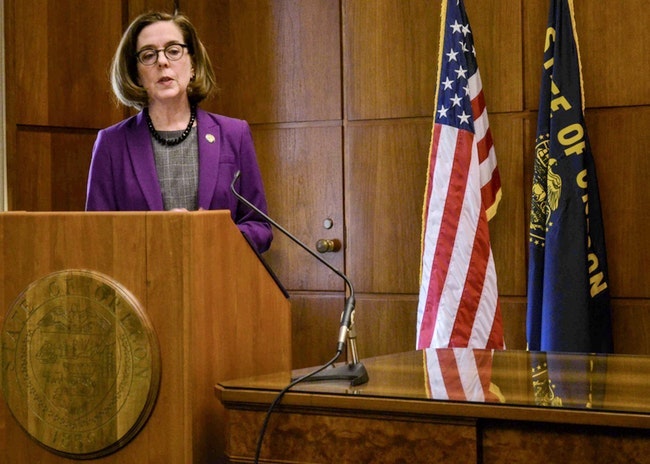
Gov. Kate Brown
Oregon health officials are taking emergency steps to confront the spread of the novel coronavirus in the state as new cases emerged over the weekend.
Testing is focused on determining the extent of the outbreak across Oregon and who is most at risk, according to Pat Allen, director of the Oregon Health Authority.
Gov. Kate Brown on Saturday night declared a state of emergency.
“I find that the novel infectious coronavirus has created a threat to public health and safety and constitutes a statewide emergency,” the governor said in her formal declaration issued Sunday.
DOCUMENT: Governor’s declaration of emergency
As a result, major hospitals around Oregon are being cleared to conduct their own tests to detect COVID-19, a volunteer corps of retired medical professionals is being activated to help particularly in rural areas, and work groups are devising counsel for communities to deal with vulnerable populations, including one for homeless and one for elderly in congregate care.
The extraordinary steps followed new test results Saturday that identified seven new cases of people presumed infected with the disease. That included five in Washington County, and one each in Douglas and Marion counties. Statewide, health officials said 14 people have tested positive for the respiratory disease.
State and county health officials were releasing few details about those infected. They confirmed one case involved a student from a Hillsboro middle school, where cleaning crews worked Sunday to prepare for the school to open Monday morning.
Of the new cases, three people were hospitalized at the time of the diagnosis and the other four were recovering at home with what health officials said were mild symptoms of COVID-19.
Four of the new cases involved individuals who had contact with other infected people. But in three cases, health officials said they don’t know the source, attributing the illness to “community spread.”
In all cases, health officials immediately launched contact investigations, identifying where the infected person had been in the days before their diagnosis and with whom they had contact. Individuals found to have had close contact with an infected patient are subsequently monitored.
As of Sunday, the Oregon Health Authority reported 203 people were being monitored. Another 290 were no longer being monitored after medical professionals determined they didn’t have symptoms or weren’t at risk.
The coronavirus is spread through person-to-person contact through coughing and sneezing, close contact such as touching or shaking hands, or touching a surface with the virus on it and then touching the face, according to health officials.
Most people who contract the virus will have symptoms similar to the common cold but in some instances the illness can produce serious effects and lead to death. So far, 19 people have died of COVID-19 in the U.S.
On Sunday, county health officials urged those who may be ill to avoid visits to individuals in long-term care facilities or hospitals and those with chronic medical conditions.
They stopped short of recommending that people avoid group events. Across the U.S., event organizers have begun postponing or canceling major events.
In Oregon, state officials Sunday urged that schools at all levels take extra precautions but said closing should be “a measure of last resort,” according to a joint statement from state and health education officials.
“The guidance recommends against closing schools and campuses where no cases of COVID-19 are present,” the statement said.
The officials noted that schools provide the “only ready access to health care and food” for many students, noting Oregon has an estimated 22,000 homeless students.
Schools should instead increase efforts to promote good handwashing, clean high-traffic areas more often and take steps such as “staggering recess and lunch periods to reduce the number of students coming into close contact with each other,” the statement said.
Meantime, state officials are pursuing additional funding to support efforts to track and contain the coronavirus. The state Emergency Board is expected to consider a request on Monday for an extra $5 million and Brown is awaiting word on whether her request for at least $7.5 million in additional federal funding would be granted.
Allen, the health authority director, said he expected “resource stresses” across the state, including in urban areas.
The state’s 62 hospitals “are committed to providing critical inpatient and community health services to respond to this evolving situation,” according to a statement from Becky Hultberg, president of the Oregon Association of Hospitals and Health Systems.
The hospitals have more than 6,000 patient beds, with 33 hospitals having 50 or fewer beds and 12 of them at least 20 miles from a neighboring hospital.
“We are working with the state administration to address important issues such as inpatient capacity, additional supplies and equipment to keep our workers and patients safe, regulatory relief to ensure adequate staffing and clarity around changing requirements,” Hultberg said.
Allen said the state expected to relax rules governing telemedicine, particularly to boost the capability of rural medical professionals to provide care without overloading medical facilities. Such long-distance care can be effective to evaluate and direct treatment, Allen said.
In her declaration, Brown directed state agencies to provide as necessary guidance to businesses “regarding appropriate work restrictions” and urged consumers who believe there has been price gouging for essential supplies to report that to the state Justice Department.
She also directed her order at all Oregonians.
“All citizens are to heed the advice of emergency officials with regard to this outbreak. In order to protect their health and safety,” her order said.




